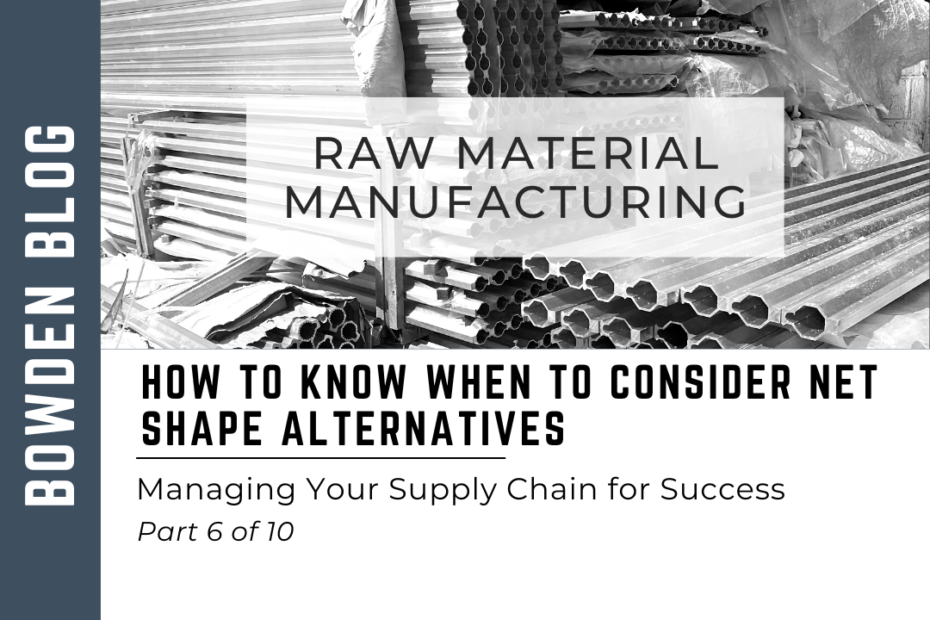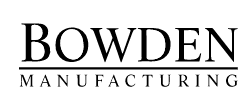Managing Your Supply Chain for Success
Part 6 of 10
We continue our Managing Your Supply Chain Series and our next topic involves Raw Material options.
The type of Raw Material used for your project as it ramps into full production is rarely the same form of Raw Material you used at the outset. Greater production levels yield opportunities for alternative forms of Raw Material to be cost-effective. Being aware of all the options for Raw Materials for your specific situation will help you build the most economical manufacturing processes.
Since we are both a Vendor to some companies and a Customer to others, we deal with both sides of this Raw Material equation, and we’ve seen the project Lifecycle play out with a wide variety of products.
This week, we’ll pose three questions for you to consider regarding Raw Material and the potential for it to change over the Lifecycle of your projects:
1. How do you determine the best Raw Material to use for your project start-up?
One of the key factors that you need to consider when you are starting a new project is what form of Raw Material will be the most cost-effective, quickest, and easiest path to get to market. Most new projects are mini experiments based on what you think prospective Customers will want. Getting samples produced that can be used to verify market demand is an important first step. Typically, the initial samples cost significantly more per part than the production parts will, but the small number produced is helpful to validate the design and establish market fit.
With recent advances in 3D CAD (Computer Aided Design), you can see more clearly than ever how parts will fit together. You can also simulate stress testing and other properties more effectively than in the past. 3D printing is often used during the initial concept formulation to bring those 3D CAD models to life. Unless the part is plastic or another routinely 3D printed material, it’s likely that you’ll need a small lot of prototype parts produced in a more representative material for both product testing and demonstration to the marketplace.
The more cost-effective you can produce the early samples, the quicker you can get feedback to see which projects have the most potential in the marketplace.
2. Is Your Initial Production Quantity Enough to Justify Getting Creative with Your Raw Material?
After getting market feedback and determining that your product is viable in the marketplace, you’ll commit to an initial production run. There are several key factors that you’ll use to determine your method of production and the associated Raw Material:
- Initial Production Quantity – Based on your samples, your market research, and your confidence that you can sell them, how many are you willing to make? Typically, the more you make that you “know” you can sell, the lower your cost per piece is to produce them. Pre-orders would be nice, but they are rarely available to justify your quantity. Ultimately, you make your most educated guess based on the best information you’ve gotten to this point in the process.
- Product Geometry – Sometimes, you might be limited in your options based on the nature of the part. It is possible the part shape will drive the production equation more than other factors. If there are specific features that only lend themselves to a particular form of Raw Material, you may have limited options. Depending on the cost associated with that form of Raw Material, the decision to kick off the project may be more costly than is worth the risk.
- Tooling Cost – Outside of off-the-shelf Raw Material, a Tooling Cost is often part of the Net Shape Raw Material equation. Understanding the up-front investment needed to kick the project off will factor into your decision-making. Calculating the total cost of the project and the amount of cost per piece that the Tooling adds will provide you additional insight into your path forward.
- Budget – Larger companies often require project budgets to keep track of the various phases of a project launch. An appropriate budget can help keep the project within spending limits based on the potential sales opportunity. In some cases, there is a separate budget for Tooling. Having dollars set aside for that purpose can be helpful but care should be taken to prevent overspending simply because the allocation is from a different “bucket.”
3. Full Scale Production – When do Net Shape Raw Material options come into play?
Your project goes well, and you move into full scale production. Even as your Team is optimizing the product based on market feedback, you know that taking advantage of a successful product includes reducing the product cost. For many products, Net Shape Raw Materials can be part of that equation.
Without restating the August 5, 2022 Blog 3 Ideas to Select the Right Material for Your CNC Machined Products That Will Save You Money, there are ways to reduce manufacturing costs as the quantities increase.
Injection-molding, casting, forging, extruding, and other Net Shape Raw Material forms typically have front-end costs associated with them but using the right process for the part material and geometry will pay off if the volume is realized. Understanding that your products have a Lifecycle and what factors are driving your demand in the market will help you match the Net Shape Raw Material process that best matches your circumstance. Your choice should set you up to keep pace with market demand without overproducing. Managing the supply and demand curve over the product’s Lifecycle is an important factor in the overall success of your project. You don’t want Customers screaming for parts they can’t get any more than you want your CFO screaming that you’ve got warehouses of inventory parts you can’t sell.
Final Thoughts
Selecting and managing the type of Raw Material you use for your project over the product’s Lifecycle is an integral part of the success you want to achieve. Cost-effectively getting your product to market to verify demand starts the process. Establishing an appropriate initial production plan based on a variety of Raw Material and market factors will help you launch your project effectively. Managing the product over its Lifecycle and including appropriate Net Shape Raw Material options can help you meet market demands without over-producing.
In part 7 of our Managing your Supply Chain for Success Series, we’ll discuss First Article production samples and how they can impact the product launch process.

